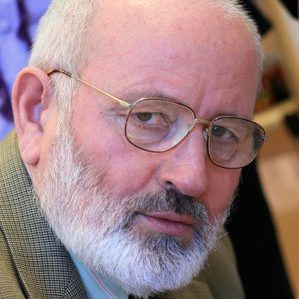Ilus málnát, szamócát, medvehagymát árult a piacon, de Károly inkább a kezét kérte meg Ilus még akkor sem tudott örülni, mikor a postás meghozta az első nyugdíját. Minek? Éppen annyit... Tartalom megtekintése
Time travel in the Kálnoky castle in Micloșoara
There is no greater experience, when in a historic place a professional guide who has all the relevant information and enthusiastically passes on his knowledge to the visitors. A well-prepared museologist with good performing skills is a great treasure. But by no means diminishing the merits of such a guide, it is an even greater experience when the visitor is guided by Matthias Kálnoky through their own garden and castle. He is a descendant of a historical comital family that has a half a millennium of history at this stormy fated building.  This encounter is even more special, because I am separated by many hundreds of kilometers from my talking partner. I have taken these photographs on a previous visit. We both sat in front of our computer screen, watched the same shots and heard each other’s voices on the phone.
This encounter is even more special, because I am separated by many hundreds of kilometers from my talking partner. I have taken these photographs on a previous visit. We both sat in front of our computer screen, watched the same shots and heard each other’s voices on the phone.
– If we come to Micloșoara (Miklósvár) from Baraolt (Barót), we cannot see the castle. It is hidden behind a long wall that serves as a fence on the edge of the village. From the gate a charming promenade can already be seen, and behind the trees appears the silhouette of a building.
– The alley leading to the courtyard of the castle is the only part of the park that has survived since communism. Unfortunately, when the Communists took over the park of the castle, the entire park was demolished. They cut down the trees, stuffed the lake, dug up the gardens.
– Walking along the alley, the castle slowly appears. In front of the building is the hedge of the landscape-garden on the right. Has it also been replanted?
– Yes. We had to rebuild the lake and the renaissance park and almost everything from scratch.
– That little pavilion with a shingle roof is very nice.
– In that place used to be a chapel in the old times that looked like this pavilion.
– It is very picturesque to photograph the castle in the mirror of the pond with the water lilies on it.
– We’re standing in front of a five-hundred-year-old building. It appeared in the records in the 1550s, when the Transylvanian principality was founded in 1568. It was probably built by Peter Kálnoky. It was around this time when the Kálnoky family got Micloșoara. When János Zsigmond tried to tax the Szeklers, he met with resistance. On the other hand he rewarded the nobles who remained faithful to the future prince. This is how the Kálnoky family moved to Micloșoara, which was also the center of this region. The Szekler counties did not work as we currently know. At that time the administrative units of the principality were called “szék”, and within the szék were smaller regions, “boys’ szék”. Micloșoara was one of the filial szék of Sepsiszék. Within Háromszék county, there are three szék that used to be merged. This castle was the administrative center of the Micloșoara szék, and at the same time a residency.
– At the end of the promenade a spacious green lawn opens up, and from here nothing blocks the view to see the whole castle. 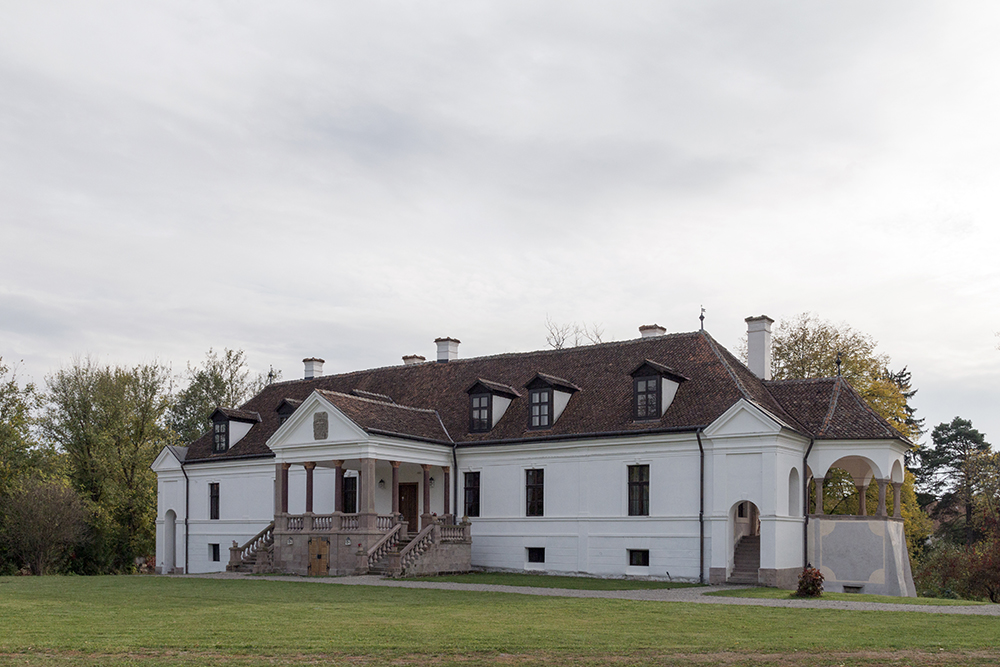 – In addition to the main entrance with a neoclassical porch, a staircase also leads to the right, there is an open tower. It was originally the main entrance to the castle. When the castle was built in the 16th century, it did not look exactly like this. The towers and the main entrance were missing from it, the only entrance was in the open tower. Only a wooden staircase led up there. New elements have been added during the centuries. It is also important to note that this was not the first castle of the Kálnoky family. At that time they lived in Valea Crișului (Sepsikőröspatak), they had another bigger castle there, which I would rather call a fortress castle. Today, I would rather call this castle in Micloșoara a hunting lodge, which means that they did not live there permanently, but only at certain times of the year, especially in the autumn. The count (or more precisely the master as the family was created comital later) also resided here when he had some administrative tasks or it was harvest time or there were disputes between the locals living there and they brought them before the nobleman who judged them as royal judge.
– In addition to the main entrance with a neoclassical porch, a staircase also leads to the right, there is an open tower. It was originally the main entrance to the castle. When the castle was built in the 16th century, it did not look exactly like this. The towers and the main entrance were missing from it, the only entrance was in the open tower. Only a wooden staircase led up there. New elements have been added during the centuries. It is also important to note that this was not the first castle of the Kálnoky family. At that time they lived in Valea Crișului (Sepsikőröspatak), they had another bigger castle there, which I would rather call a fortress castle. Today, I would rather call this castle in Micloșoara a hunting lodge, which means that they did not live there permanently, but only at certain times of the year, especially in the autumn. The count (or more precisely the master as the family was created comital later) also resided here when he had some administrative tasks or it was harvest time or there were disputes between the locals living there and they brought them before the nobleman who judged them as royal judge.
– Before we walk through the door, let’s stop and read the motto of the family over it. In latin language, carved in stone…
– “Non est mortale quod opto”. One who has faith must not be afraid of death. The Kálnoky family remained Roman Catholic even after the Reformation. The monastery and the chapels were supported by them in Şumuleu Ciuc (Csíksomlyó), and the same motto can be found in one of them.
– I think this motto was necessary for such a rebirth after communism.
 – The Kálnoky family owned the property until 1888. Then Dénes Kálnoky died without an heir, so his nephew, the son of Dénes’ sister, Ferenc Seethal and his family inherited it. They lived in the castle for two generations. Ferenc Seethal Jr. also died without an heir in 1940. In Hungary a family named Bittó inherited the estate, but they did not want to have a castle in Romania, because in the meantime the borders changed and it was sold to the Romanian Minister of Finance, named Eugen Savu. He timed the purchase quite badly, as the estate, six months after the deal together with Northern Transylvania, returned to Hungary. Then Savu did not want a castle in Hungary and leased it to the Hungarian Royal Treasury, the Hungarian state, which set up military barracks for the local Szekler border guard units. The border was not far from Micloșoara in that Hungarian period, and therefore it was important to establish military bases there. At the end of the World War, the Romanians changed sides and returned with the Russians. Stalin gave back Northern Transylvania to Romania as a reward for their transition. Savu was then able to vacation in the castle for another two years because the Communists came in ‘47 and took everything away. He was not deported because he was not a nobleman, but his castle was confiscated without compensation. For the next fifty years, there was a so-called “cultural center” in the building. It was lucky in many ways. Unlike other castles, it was not converted into a warehouse like in Brâncoveneşti (Marosvécs) or, like in Târgu Mureş (Marosvásárhely), a madhouse.
– The Kálnoky family owned the property until 1888. Then Dénes Kálnoky died without an heir, so his nephew, the son of Dénes’ sister, Ferenc Seethal and his family inherited it. They lived in the castle for two generations. Ferenc Seethal Jr. also died without an heir in 1940. In Hungary a family named Bittó inherited the estate, but they did not want to have a castle in Romania, because in the meantime the borders changed and it was sold to the Romanian Minister of Finance, named Eugen Savu. He timed the purchase quite badly, as the estate, six months after the deal together with Northern Transylvania, returned to Hungary. Then Savu did not want a castle in Hungary and leased it to the Hungarian Royal Treasury, the Hungarian state, which set up military barracks for the local Szekler border guard units. The border was not far from Micloșoara in that Hungarian period, and therefore it was important to establish military bases there. At the end of the World War, the Romanians changed sides and returned with the Russians. Stalin gave back Northern Transylvania to Romania as a reward for their transition. Savu was then able to vacation in the castle for another two years because the Communists came in ‘47 and took everything away. He was not deported because he was not a nobleman, but his castle was confiscated without compensation. For the next fifty years, there was a so-called “cultural center” in the building. It was lucky in many ways. Unlike other castles, it was not converted into a warehouse like in Brâncoveneşti (Marosvécs) or, like in Târgu Mureş (Marosvásárhely), a madhouse.  There was a Romanian filmmaker who set fire to the castle of Bonchida because he needed a burning castle in his film for ten seconds. In comparison, the castle of Miclosoara survived communist times quite well. So it was a cultural center until the change of regime. After that came the real ravaging. When the Communists left, there were a few years when no one was in charge. Locals took advantage of this opportunity. They took down the roof tiles, knocked down the walls, took everything that could be moved. There was quite a lot of damage in those few years between ’89 and ’94. And then my father, Tibor Kálnoky, returned. I have already mentioned that the last owner was not a Kálnoky, so we could not reclaim it like our castle in Valea Crișului but Savu’s heirs did not reclaim it either, so in 2004 we managed to rent it out for 49 years. This means that the castle is now actually state-owned and we have invested in renovating it.
There was a Romanian filmmaker who set fire to the castle of Bonchida because he needed a burning castle in his film for ten seconds. In comparison, the castle of Miclosoara survived communist times quite well. So it was a cultural center until the change of regime. After that came the real ravaging. When the Communists left, there were a few years when no one was in charge. Locals took advantage of this opportunity. They took down the roof tiles, knocked down the walls, took everything that could be moved. There was quite a lot of damage in those few years between ’89 and ’94. And then my father, Tibor Kálnoky, returned. I have already mentioned that the last owner was not a Kálnoky, so we could not reclaim it like our castle in Valea Crișului but Savu’s heirs did not reclaim it either, so in 2004 we managed to rent it out for 49 years. This means that the castle is now actually state-owned and we have invested in renovating it.
– Your father has found the place, as you said, in a rather poor condition. However he still saw some opportunity in it. Today, there is a new roof tile in the place of the stolen roof tile, the location of the damages is not visible, and the building is a home to a beautiful museum.
– Yes, the building was in ruins for a long time. The renovation took place between 2015 and ’17. Liechtenstein, Iceland and Norway supported the work. Thanks to this, it now houses the Museum of Transylvanian Life. Shall we go in?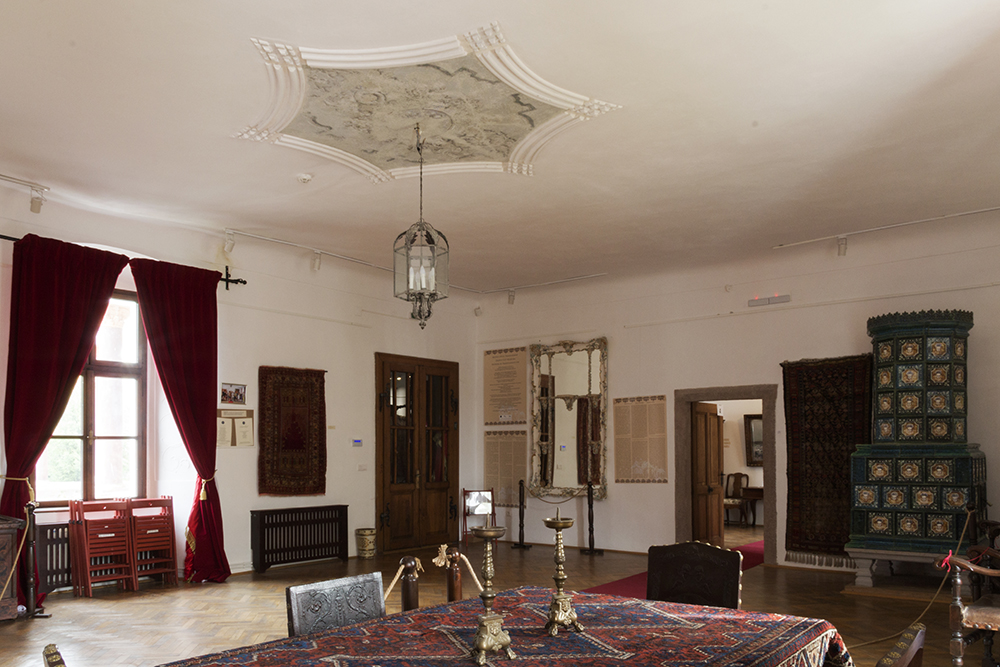
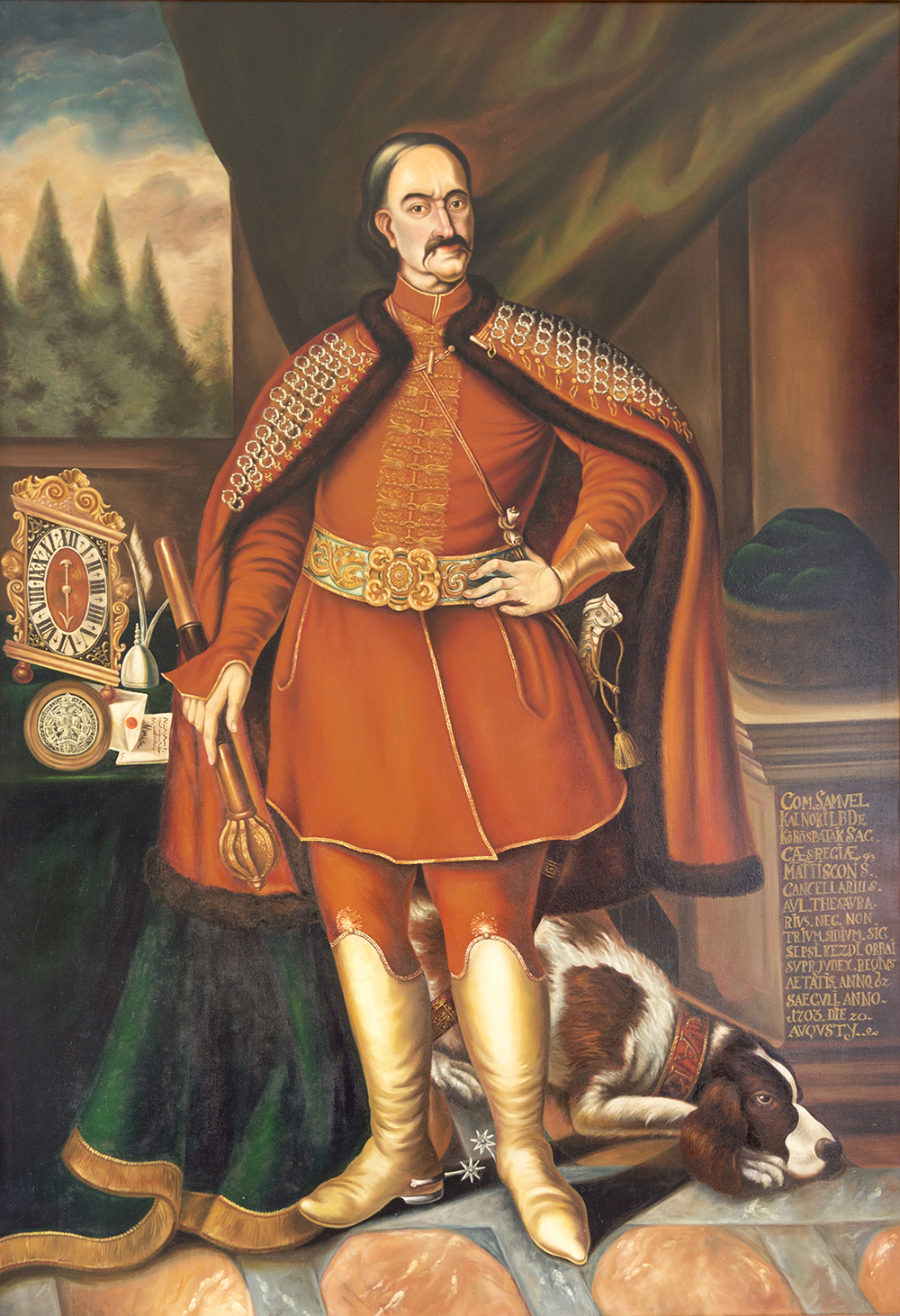 – First we go through a small room with a guest room to the right. From here we reach a hall called the Grand Palace. If you are not in the castle of Miklósvár, you do not know what to think of the term Grand Palace inside the building.
– First we go through a small room with a guest room to the right. From here we reach a hall called the Grand Palace. If you are not in the castle of Miklósvár, you do not know what to think of the term Grand Palace inside the building.
– It was just an idea when we gave the rooms a name. Palace Hall would actually be a better name because it is the largest room…
– And this is the place of events according to the pictures I found on the World Wide Web. Starting from the left corner, we can see a very nice portrait painting above the harpsichord.
– Samuel Kálnoky, a very important personality in our family history, lived in the 1600’s. He was the first Kálnoky to be created a count in 1697 by Emperor Leopold. In the last decades of the principality, he fought against Thököly, was in captivity for a while, and then released. He was appointed the first vice-chancellor of Transylvania by the Habsburgs. And, as far as I know, he was the last treasurer of the Transylvanian principality before it was all over. Count Samuel Kálnoky is also important because of the castle. He has started many large constructions that are still with us to this day.
– What makes a nobleman to be created a count?
– This is a bit complicated… The title of Count did not exist in Transylvania before, the Baron was of the highest rank. The Habsburgs were very religious, considering the Roman Catholic faith important, and when they came in, they selected the nobles who remained Roman Catholics. In doing so, they tried to gain their trust. In this way they were able to make these nobles faithful to the emperor.
– It is surprising how strong Reformation, Catholicism and Unitarianism are in Szeklerland. All in a not too large geographical location.
– The Parliament of Turda (Torda) declared freedom of religion in 1568. The Szeklers are fundamentally very self-aware and stand up for themselves. Well, after the Reformation, Háromszék county became predominantly Protestant, Calvinist, and Unitarian. Miercurea Ciuc (Csíkszereda), Csíkszék county remained a Roman Catholic.
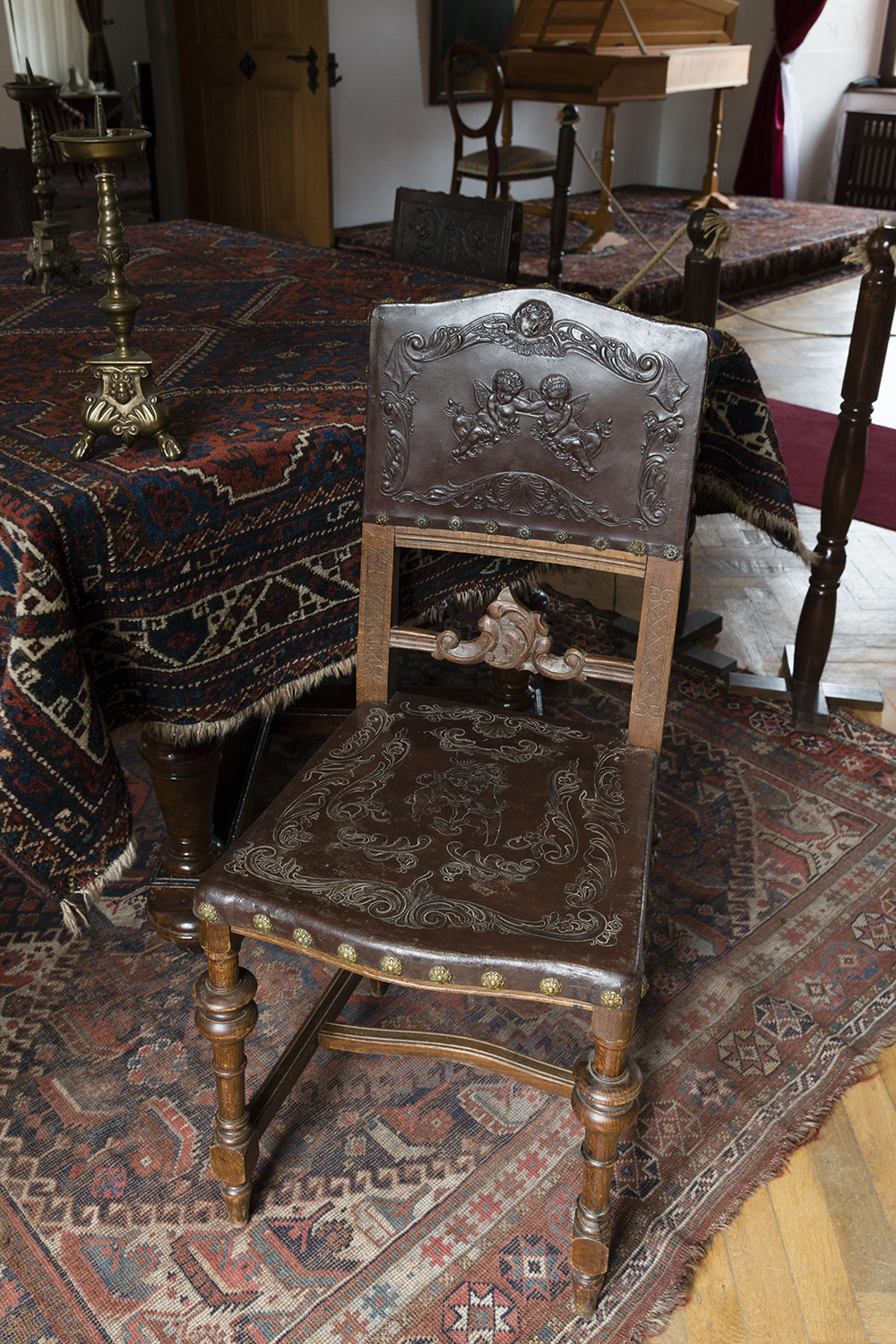 – Let’s move on from the portrait of Samuel Kálnoky! In the inner panoramic view of the Grand Palace, we can see a table and printed patterned, leather-covered chairs around it. Are they somehow connected to the older life of the castle, or are they meant to evoke the atmosphere of contemporary interiors?
– Let’s move on from the portrait of Samuel Kálnoky! In the inner panoramic view of the Grand Palace, we can see a table and printed patterned, leather-covered chairs around it. Are they somehow connected to the older life of the castle, or are they meant to evoke the atmosphere of contemporary interiors?
– They’re Old German style. As a Museum of Transylvanian Life, the museum tries to present the Transylvanian life of previous centuries. We chose from the furniture styles favored by the Transylvanian nations when the items were selected. Such chairs were used by the Saxons, for example. As I mentioned before, most of the objects come from elsewhere. In the times after the change of regime almost everything was taken away, and the rest was ruined.
– On the right side of the room we can see a tiled stove. The pattern of the tiles is very interesting. I don’t even know what to say, female face or baby face?
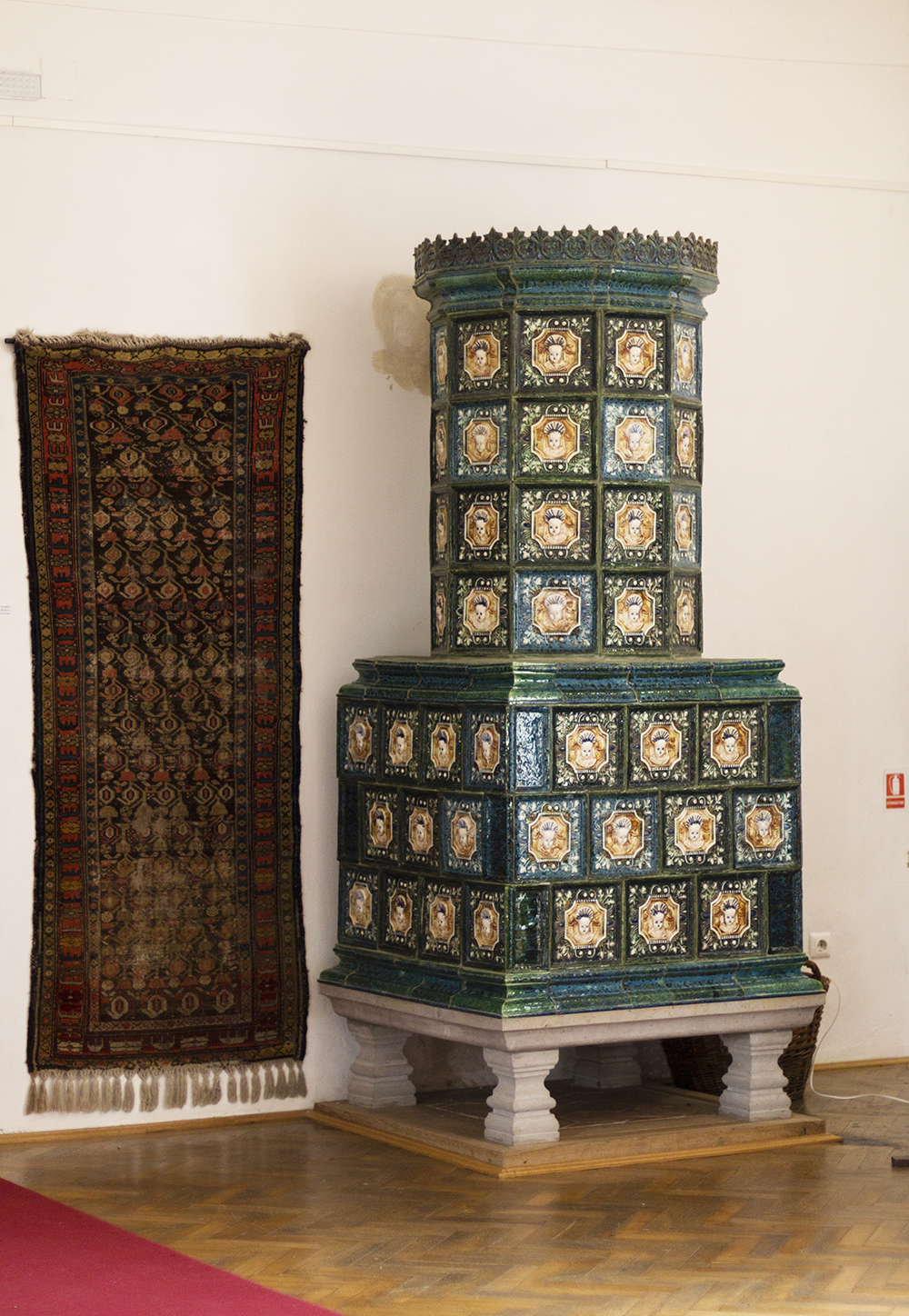 – Talking about that stove, I’d talk about all the stoves in general. There was one of them in almost every room in the castle. This was the main way of heating the castle. What we can see here are angel faces. The original version of this, and all the others, were shattered by the Communists when the regime came. However, we found pieces of it scattered underground in the cellar, in the well, and around the castle. Based on these, we managed to breathe new life into the tile stove not far from Miclosoara in Bicfalău (Bikfalva) where there is a tile manufacturer. These tiles were created by an artist from Bicfalău, Alpár Péter. It was a very long job, he painted the tiles one by one by hand. Looking up close it is clearly visible that there are more colors on the tiles, each layer had to be burned out separately. Anyway, this stove is trying to revive the style around the 1700s.
– Talking about that stove, I’d talk about all the stoves in general. There was one of them in almost every room in the castle. This was the main way of heating the castle. What we can see here are angel faces. The original version of this, and all the others, were shattered by the Communists when the regime came. However, we found pieces of it scattered underground in the cellar, in the well, and around the castle. Based on these, we managed to breathe new life into the tile stove not far from Miclosoara in Bicfalău (Bikfalva) where there is a tile manufacturer. These tiles were created by an artist from Bicfalău, Alpár Péter. It was a very long job, he painted the tiles one by one by hand. Looking up close it is clearly visible that there are more colors on the tiles, each layer had to be burned out separately. Anyway, this stove is trying to revive the style around the 1700s.
– And the rug next to it, I read somewhere, is a prayer rug.
– The rugs that can be seen in the castle are prayer rugs. They are from the 19th century and each one is original. It is important to know that the Turks had quite an influence in the history of Transylvania. In the principality and beyond. These Muslim prayer rugs spread very quickly. We didn’t use it very much for prayer, but as a decoration it fits very nicely. Most of the carpets and and the other textile items on the wall were lent to the museum by Sándor Madaras, a brain surgeon from Targu Mures (Marosvásárhely).
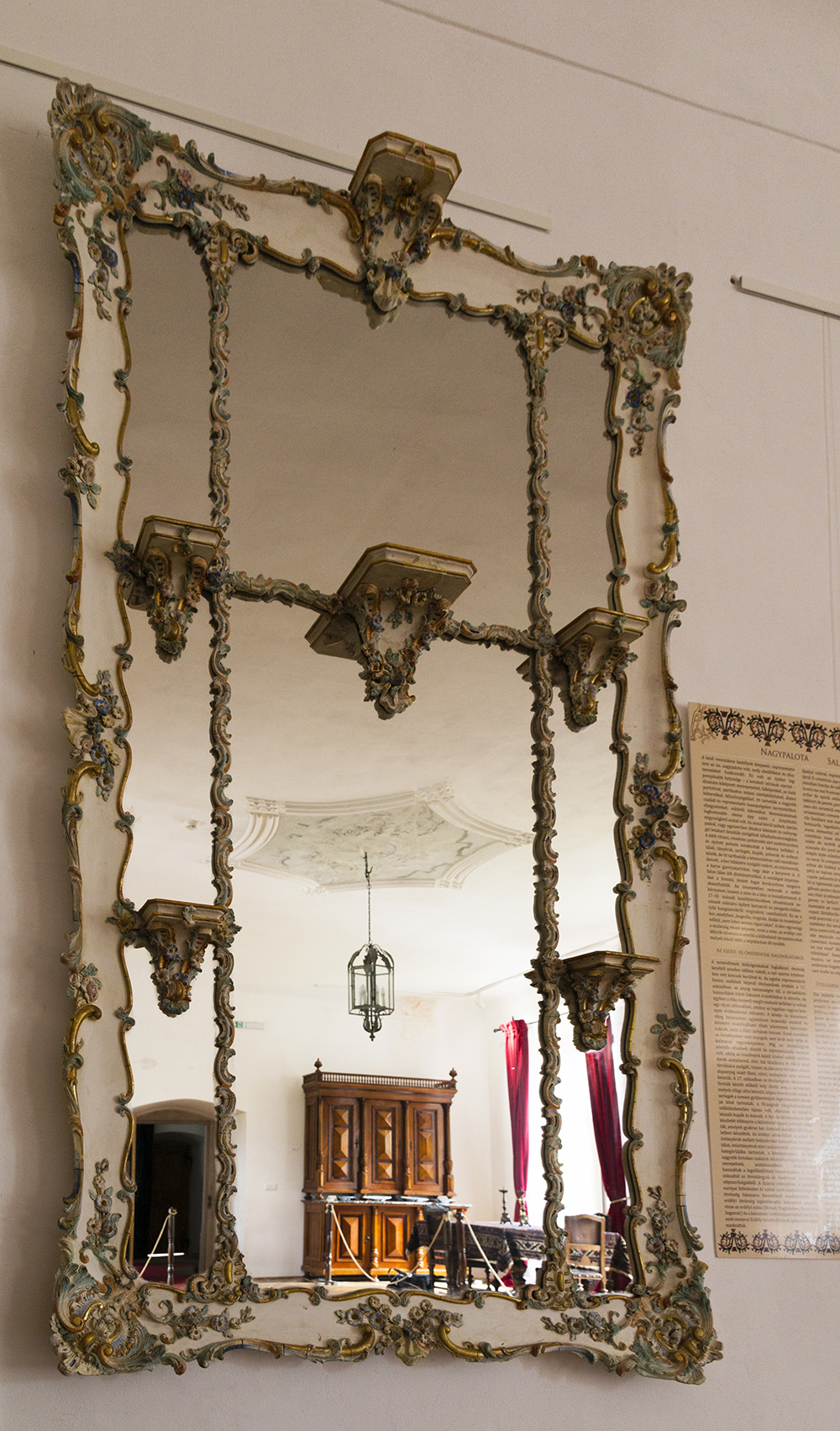 – What can be known about this Rococo mirror?
– What can be known about this Rococo mirror?
– It’s also from the 1800s. Similar ones are in French chateaus, such as Versailles, where the hands of the Communists did not reach. It has an interesting history. Hugó Kálnoky, my great-grandfather, donated some of the more valuable furniture from the Valea Crișului castle to the Roman Catholic Church before leaving Hungary. He knew that the Communists were coming, and he could not hope for much good from them. The Roman Catholic Church passed on this furniture to the Szekler National Museum. The mirror is currently the property of the Szekler National Museum in Sfântu Gheorghe (Sepsiszentgyörgy). They lent it to us a few years ago when we opened the museum. The Székely National Museum is currently under renovation, so it stayed with us for the time being. This mirror is an original Kálnoky furniture from the Valea Crișului castle.
– It made a circle trip from Valea Crișului Castle to the Szekler National Museum, from there to here, therefore from a Kálnoky Castle, to another Kálnoky Castle…
– Yes, it made a fifty-year journey and landed here.
 – For an aristocratic family, fifty years is not such a big time, especially if its history goes back as long as you told me before. One of the next two rooms are named after the lady and the next one after the lord of the house. In the first one, I took a photo of a life-size model. She is standing in contemporary wear in front of a display case. In the closet, according to the inscription on the card, are the count’s personal belongings.
– For an aristocratic family, fifty years is not such a big time, especially if its history goes back as long as you told me before. One of the next two rooms are named after the lady and the next one after the lord of the house. In the first one, I took a photo of a life-size model. She is standing in contemporary wear in front of a display case. In the closet, according to the inscription on the card, are the count’s personal belongings.
– A spike-like pattern can be observed on glassware. These pieces were made in Valea Zălanului (Zalánpatak), not far from Miclosoara. That village was founded by Samuel. He set up a glassworks, a rudimentary factory there. The original, pre-fire glass windows of the Black Church in Brasov were made there. The other glassware in the closet was also made there. These pieces are a rarity, because the glassworks only operated until one hundred and fifty years ago.
– Let’s move on from the artistic glassworks. There are other beautiful objects here. Here are these bronze clothes hangers. Utility objects that are seldom adorned so richly. Are they also here to evoke the mood of the age, like this lady with an embroidery frame and a basket of skeins of yarn?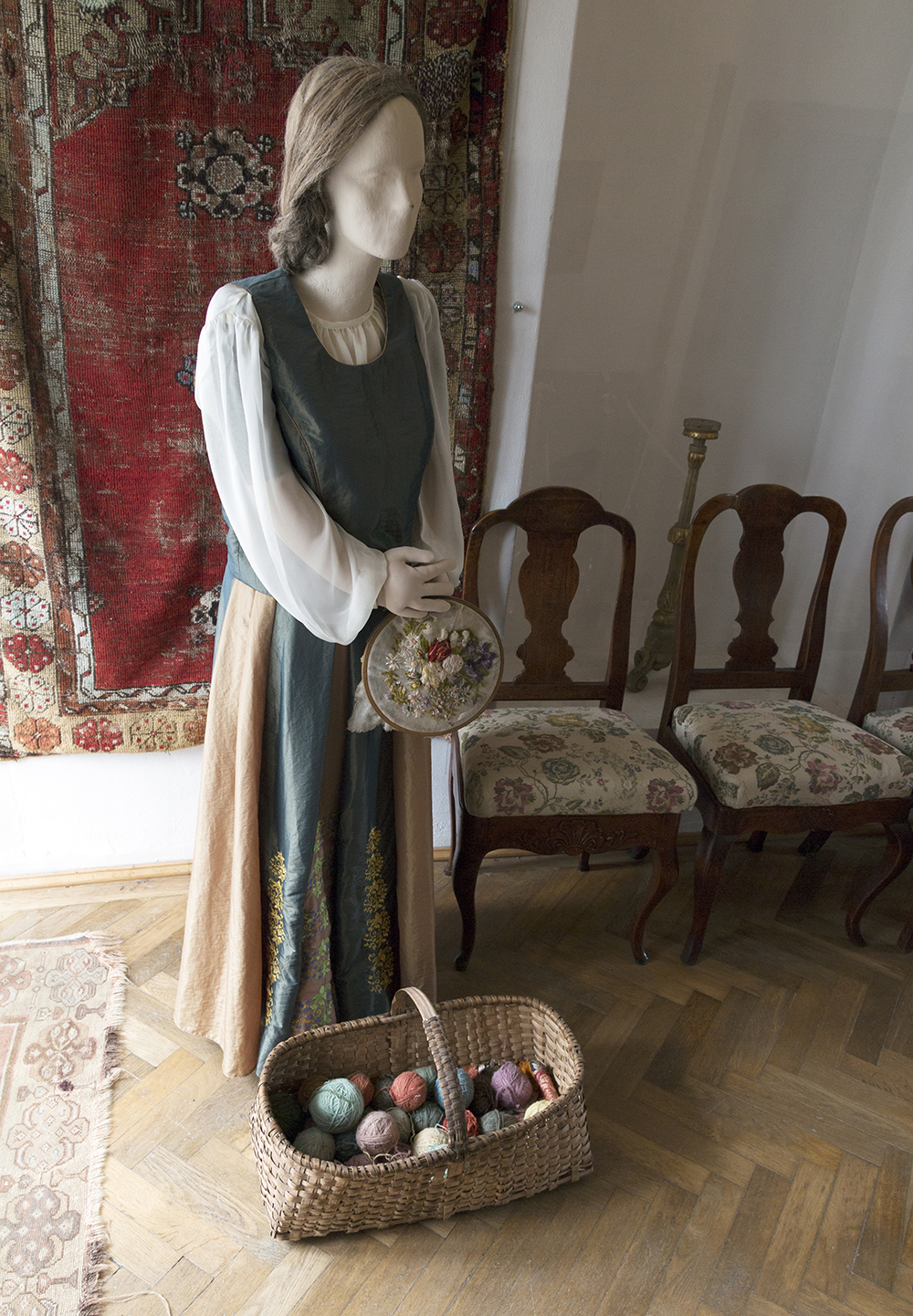
– These items were donations to the castle. I’m not sure about their authenticity, but if the bronze objects are original, they probably date from the 18th century.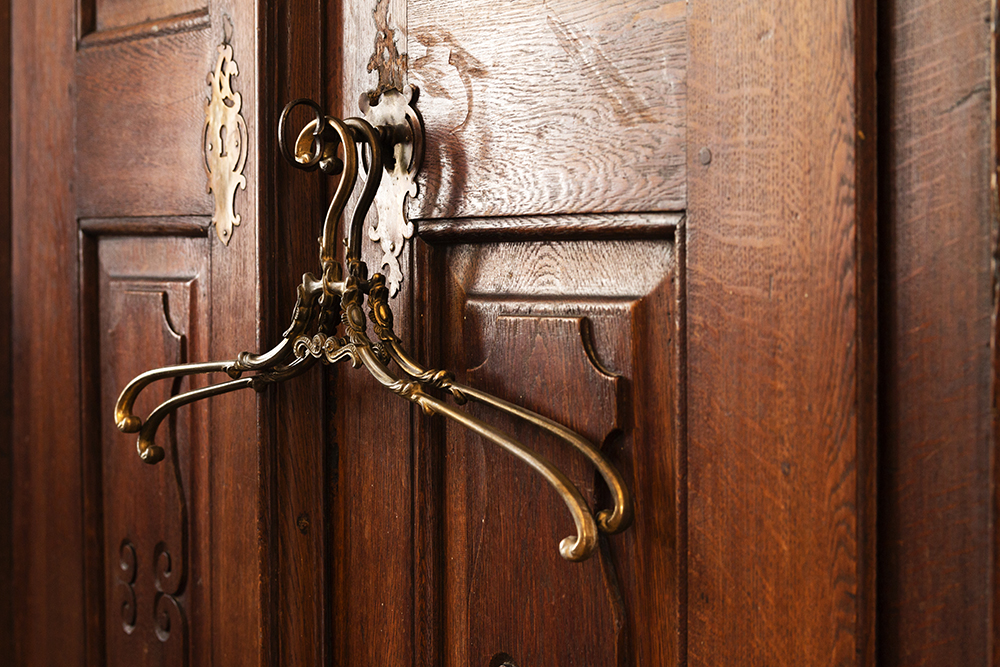
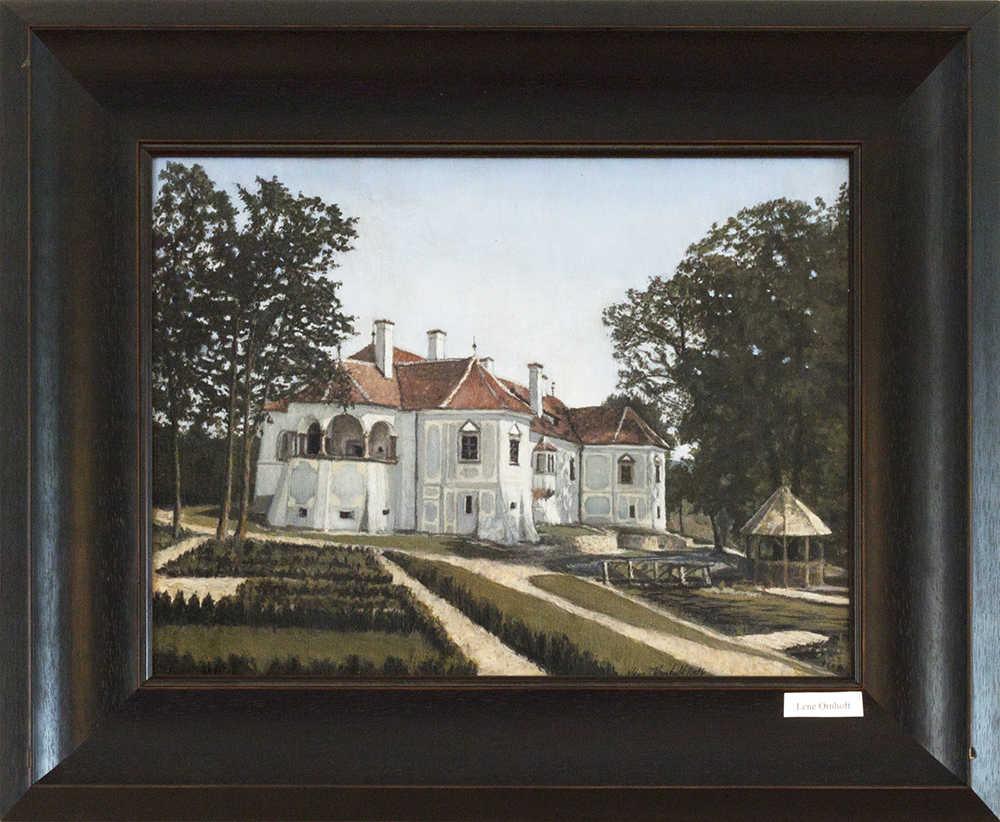
– Does the painting depicting the castle reflect a former condition or after the renovation?
– Painted in 2017 by Lene Orhoft. She donated it to the castle when we opened the museum.
– The second bedroom opens from here. Even from the outside the Art Nouveau patterned kerosene lamp under the vaulted ceiling catches the viewer’s eyes. And inside, the two beds covered with walnut root veneer create a real “retro” atmosphere. There are some like these in the guest houses handled by your family. Are they authentic contemporary ones?
– Yes. The furniture and furnishings come from antique shops, the Negreni (Körösfeketetó) Black Lake Fair, donations, almost all are authentic. They may not have originated from the castle for the reason already mentioned, but they are original, dating from the 1700s and 1800s.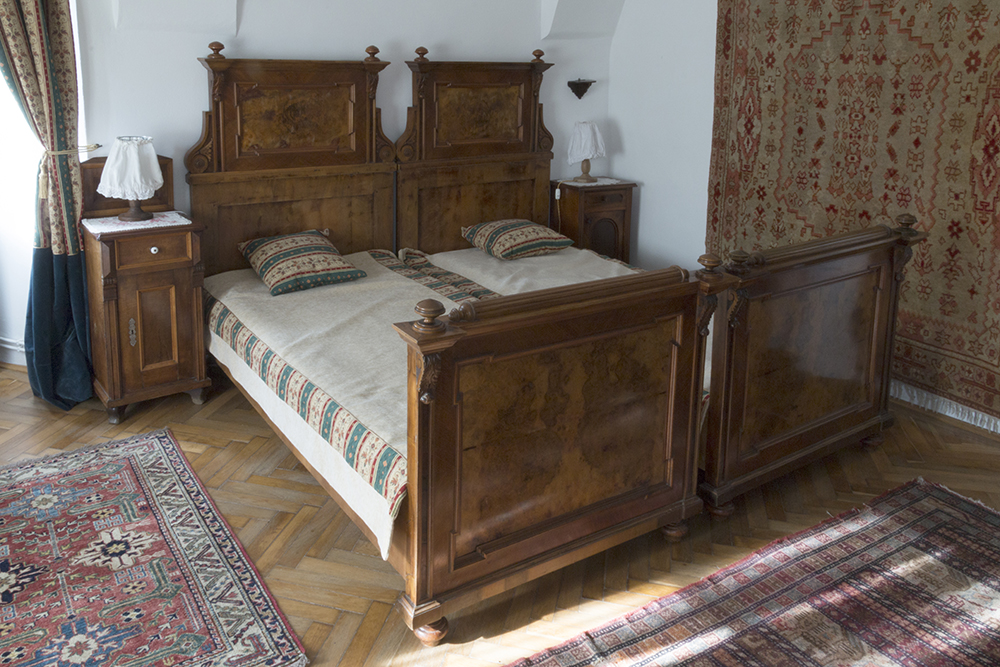
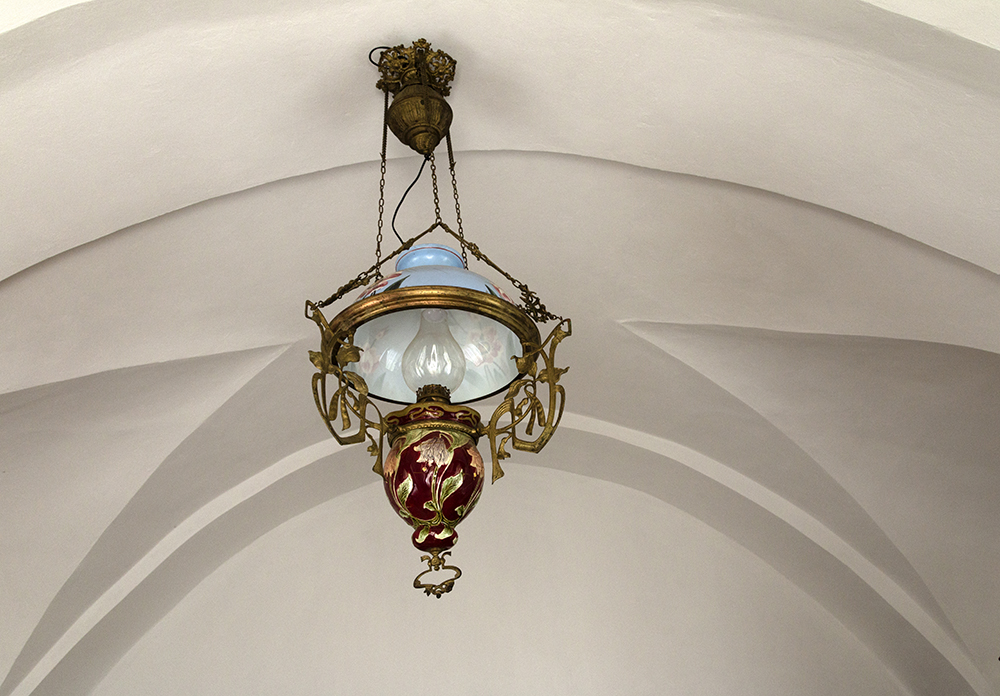
– The lord’s room that can be seen in the photograph below is the last one on this level. Before the visitor takes a look at the interior, his eyes linger in the long corridor where he has reached so far.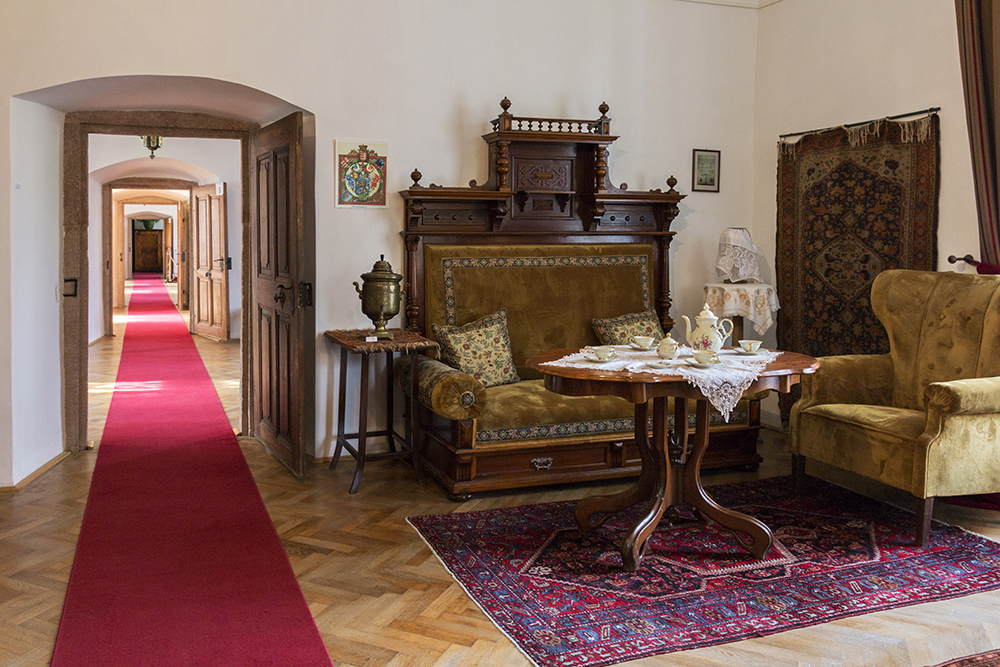 – The style of the furnishings is Old German, so we named it Old German salon. The door at the hallway closest to us is original. The rest were rebuilt on this basis.
– The style of the furnishings is Old German, so we named it Old German salon. The door at the hallway closest to us is original. The rest were rebuilt on this basis.
– It went so well that I didn’t even notice.
– There is only a slight difference in color. It didn’t even have to take the door off. Craftsmen from Háromszék county have photographed, measured it, and such a beautiful result praises the work of their hands.
– There’s another portrait painting in the castle, the second one is here in this salon.
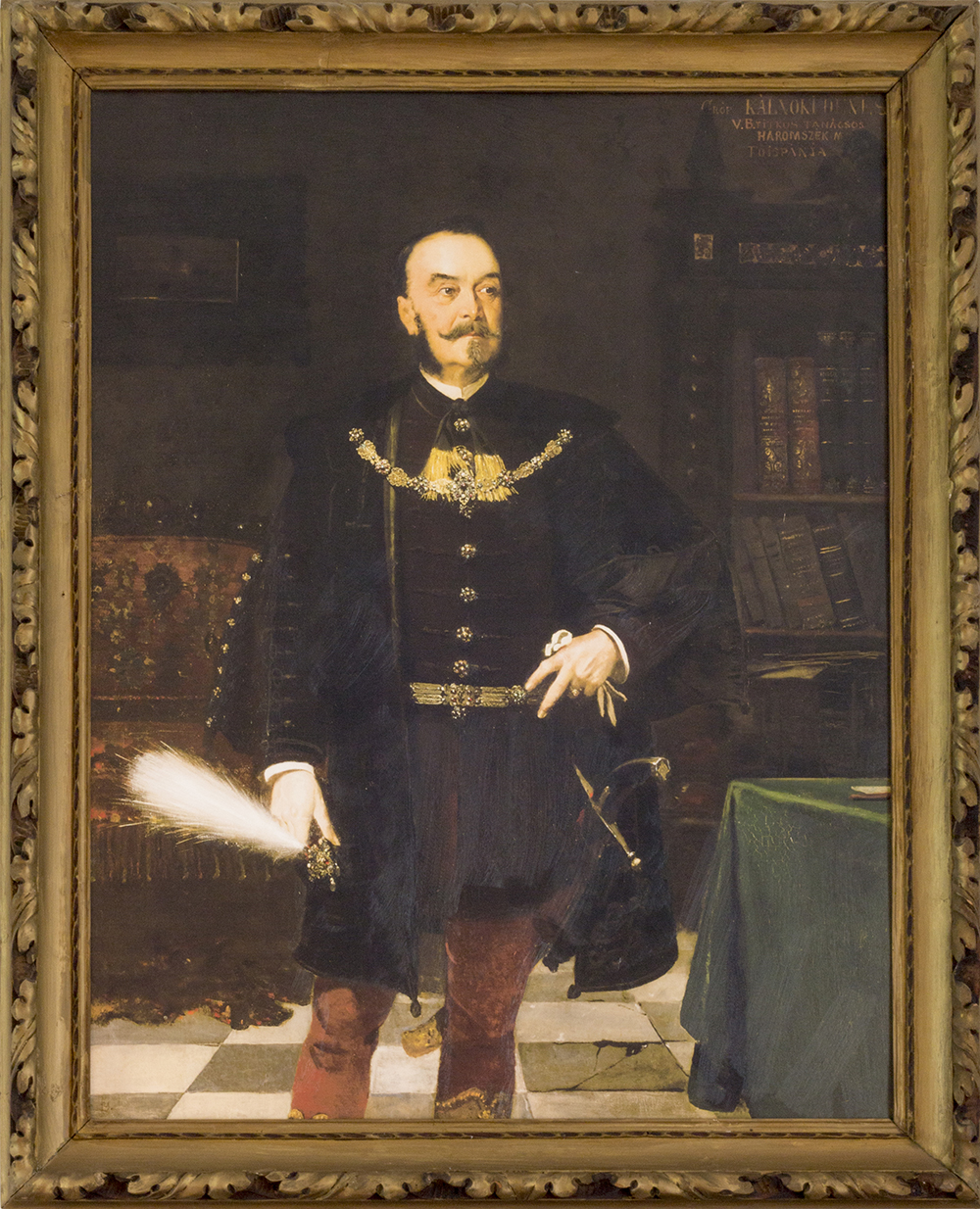 – Dénes Kálnoky, who was the last male owner from the Kálnoky family in the castle. He lived in the 1800s, his life was quite adventurous. In the 1848 Hungarian revolution he was the leader of the local Szekler resistance. After the revolution he traveled extensively, such as hunting in Africa.
– Dénes Kálnoky, who was the last male owner from the Kálnoky family in the castle. He lived in the 1800s, his life was quite adventurous. In the 1848 Hungarian revolution he was the leader of the local Szekler resistance. After the revolution he traveled extensively, such as hunting in Africa.
– Do I understand well? Dénes was just the opposite of Samuel. Samuel was awarded the title of Count precisely because of his loyalty to the Habsburgs.
– Yes, it is very interesting indeed. By the time of Dénes the family tree had already split into two branches. One of them a branch loyal to Austria, and another one a Szekler branch in Transylvania. It happened several times during the 1848 revolution that the cousins fought on the opposite side in battle. Kálnoky from Transylvania defended, Kálnoky from Austria besieged the castle. After the revolution, however, they smoothed their affairs among themselves. The persecution of Dénes was stopped with the help of the Austrian Kálnokys and he did not have to face martyrdom.
– Didn’t anyone feel like writing a nice adventurous novel based on this story? – No one wrote about it, though it really reminds of famous Hungarian writer Jókai’s novel “Baron’s sons”. On the other hand, Dénes himself wrote about his adventures. (Novels such as The memory of the wanderer and The Indar of Kalocsai) In the painting, the bookshelf behind him refers to his attraction to literature.
– We’ve reached the end of our walk in the building. From here one of the staircases leads upstairs, the other one into the basement…
– Upstairs three guest rooms are located. These were built mainly for guests of the castle during such events as weddings. Together with the two ones on the ground floor, we have five guest rooms here and ten more in the village.
My gaze runs down the red carpet in the long hallway again. Our visit to the Museum took more than an hour. It could have been even longer as Matthias Kálnoky could talk for many more hours about the interior and the rich history of his family. At the far end on the right side is a Kálnoky, created a count by the Habsburgs, and here, on the left side is another count Kálnoky who fought against the Habsburgs in the War of Independence in the ’48. An aristocratic family that not only lived the Transylvanian life but also shaped the history of Transylvania.
Hasonló
A brassói Fekete templom sz...
Medvekaland a Szent Anna tó...
Iszapfürdő és sóhegyek a Ko...
A gyergyószentmiklósi örmén...
Októberi séta Benedek Elekn...
Időutazás a Kálnokyak mikló...
Áldott a te földednek termé...
Római katolikus plébániatem...
Hol terem a furfangos széke...
Rubens oltárkép a szamosújv...
Rhédey Klaudia grófnő, Káro...
A Csorgókő Székelyvarság cs...
Vad nárciszok tengere Széke...
Kőrösi Csoma Sándor szülőhe...
Fenn a Hargitán, a székelye...
Húsvéti kakaslövés Apácán...
Szent László megmenti az el...
Acél Jézus szobor a Gordon ...
Formák, színek, vonalak, fo...
Arany erényöv Drakula kasté...
Égi áldás az özvegyasszony házasságára
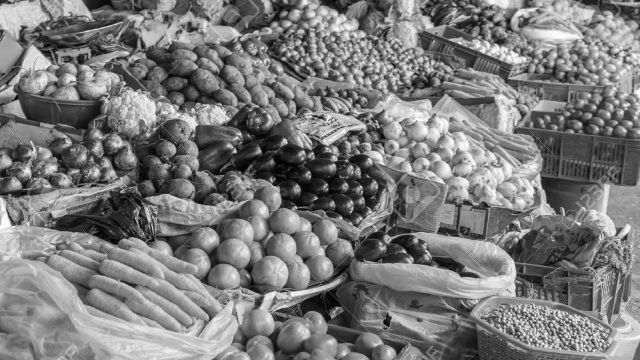
Virágvasárnap Vatikánban a Szent Péter téren
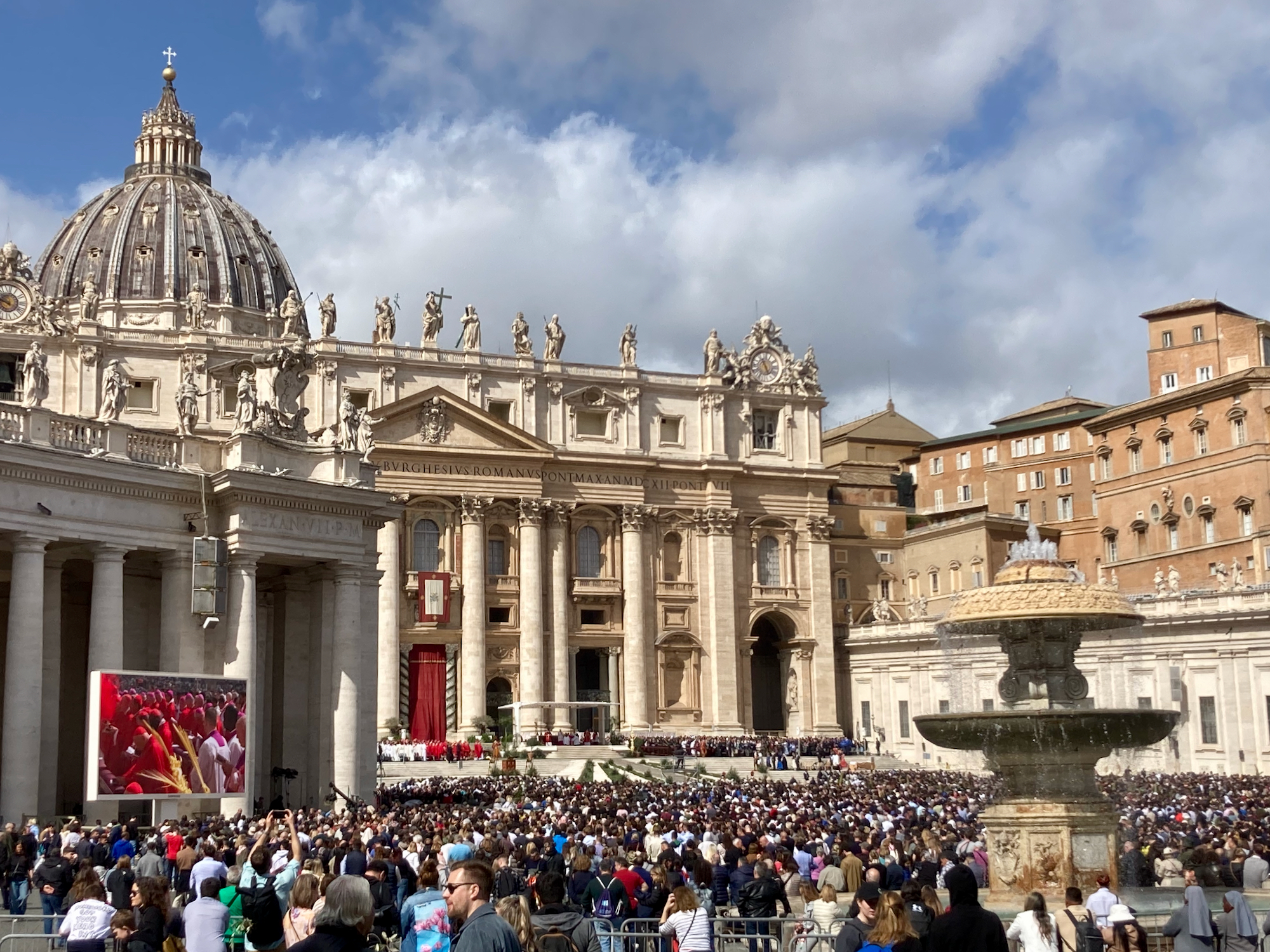
Pálmaágakból lefektetett szőnyeg a Bazilika lépcsőin, olajágakkkal integető ünneplők Ilyen meghívót kap a vendég, ha a jó sorsa Rómában egy zarándokszállásra viszi. A Casa per ferie delle Suore Missionarie Pallottine néhány... Tartalom megtekintése
Varázslat
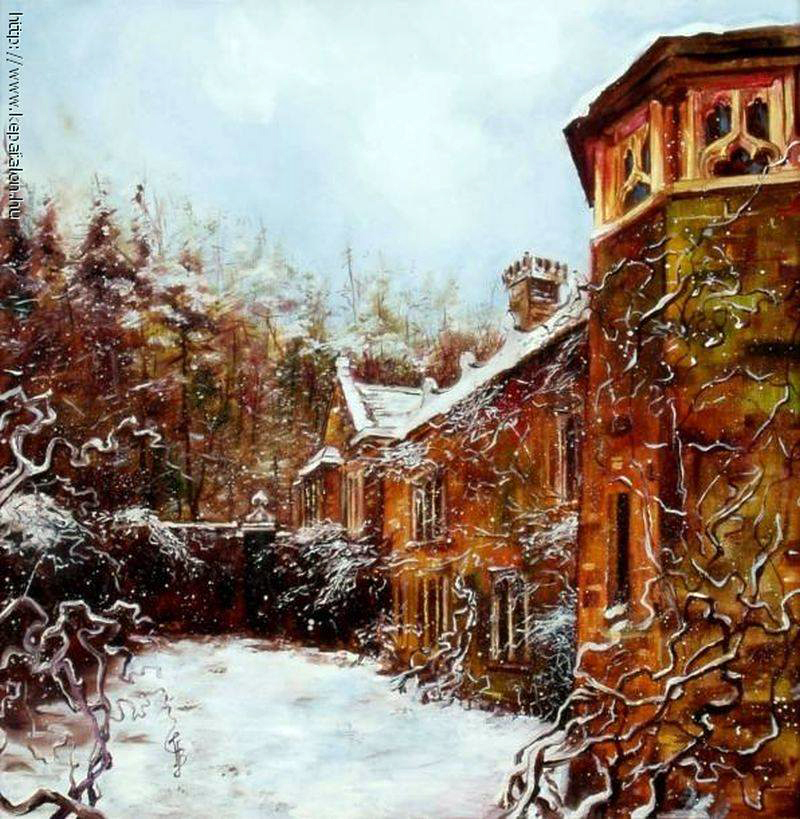
Huszár Boglárka alkotása 60×60 cm. olaj, vászon. Nem is tudom mióta áll ez a nagyon régi épület, kicsit elvarázsolt szépségével kastély, kicsit bástya szerű repkénnyel befutott oldalával. Az idő ... Tartalom megtekintése
Az út

Tüttő József alkotása Szinte meggyötört arcok, holott egy életút harcosai a születéstől a végsőkig. Egyetlen ember akinek annyiszor változik az arca, ahány állomást tudhat maga mögött. Hogy sejthetnénk gyermekkorban, milyen ... Tartalom megtekintése
Hegyet hágék, lőtőt lépék, a sárkány farkán túráztam
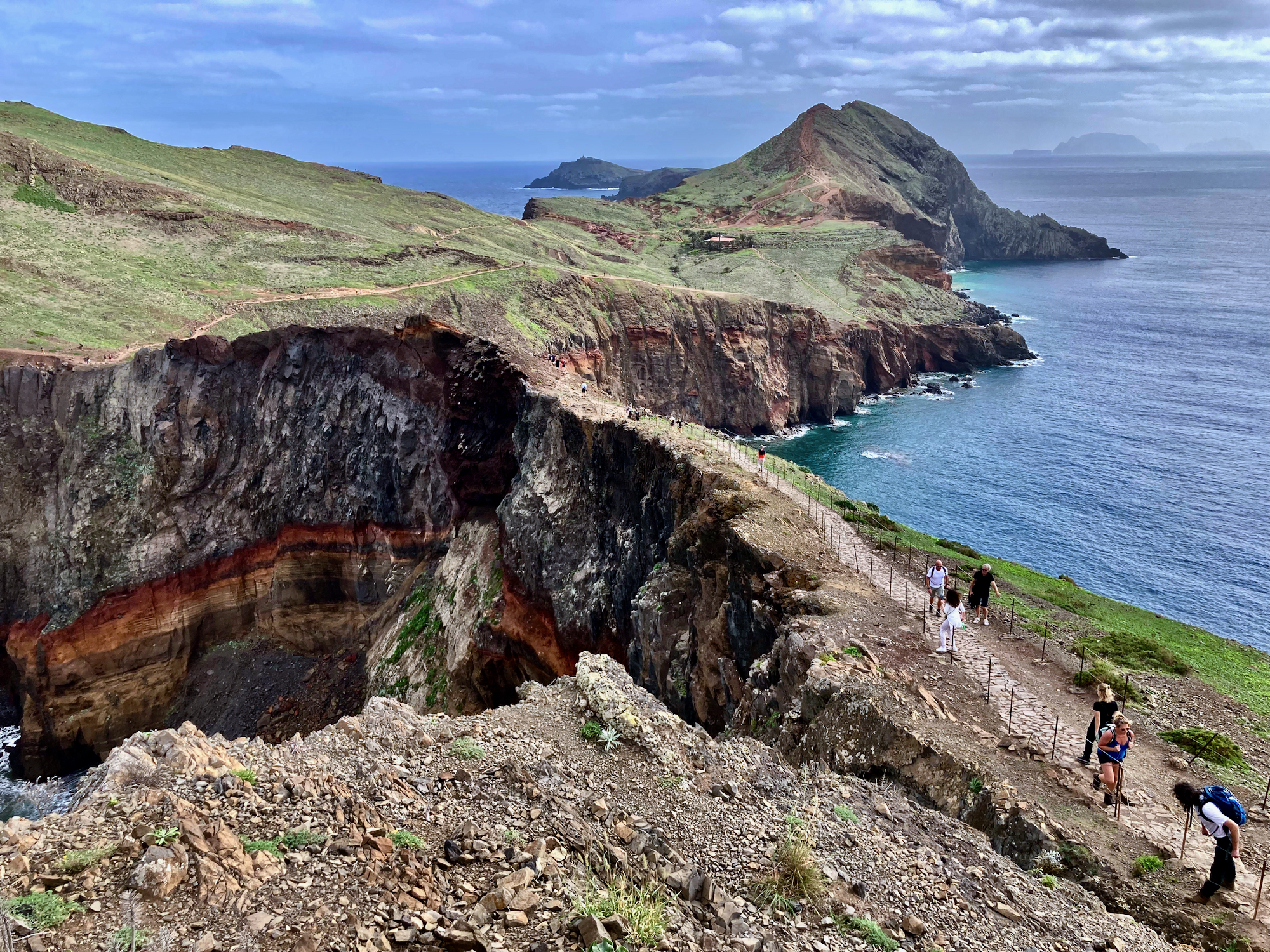
Megtépett sziklák, leszakadt hegyormok, madeirai séta egy csángó ima ritmusára Légvonalban… Ha valahol tényleg látni is lehet, mit jelent ez a kifejezés, az a Ponta de São Lourenço, azaz a... Tartalom megtekintése
Pomaranski Luca portréja

Huszár Boglárka alkotása Csak általánosságban szabad beszélni, én mégis a portrézást találom a legizgalmasabb alkotói munkának. Huszár Boglárka ragyogó képet festett Lucáról, aki csak éppen bekukkantott a vászonra, hogy ... Tartalom megtekintése
Győr Bécsi kapu tér. Egy csepp harmónia
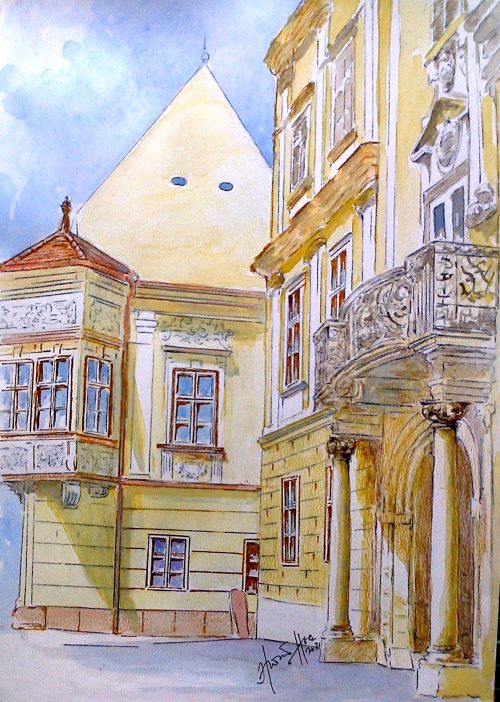
Hargitai Beáta alkotása Győr talán legszebb tere a Bécsi kapu tér. Szinte minden épülete műemlék, barokk, copf, és kora klasszicista stílusú homlokzatokkal. (Wikipédia) A tér ragyogása, elegánsan hangolt épületei a ... Tartalom megtekintése
Egy kis nyelvészkedés a Piña Coladaval kapcsolatban
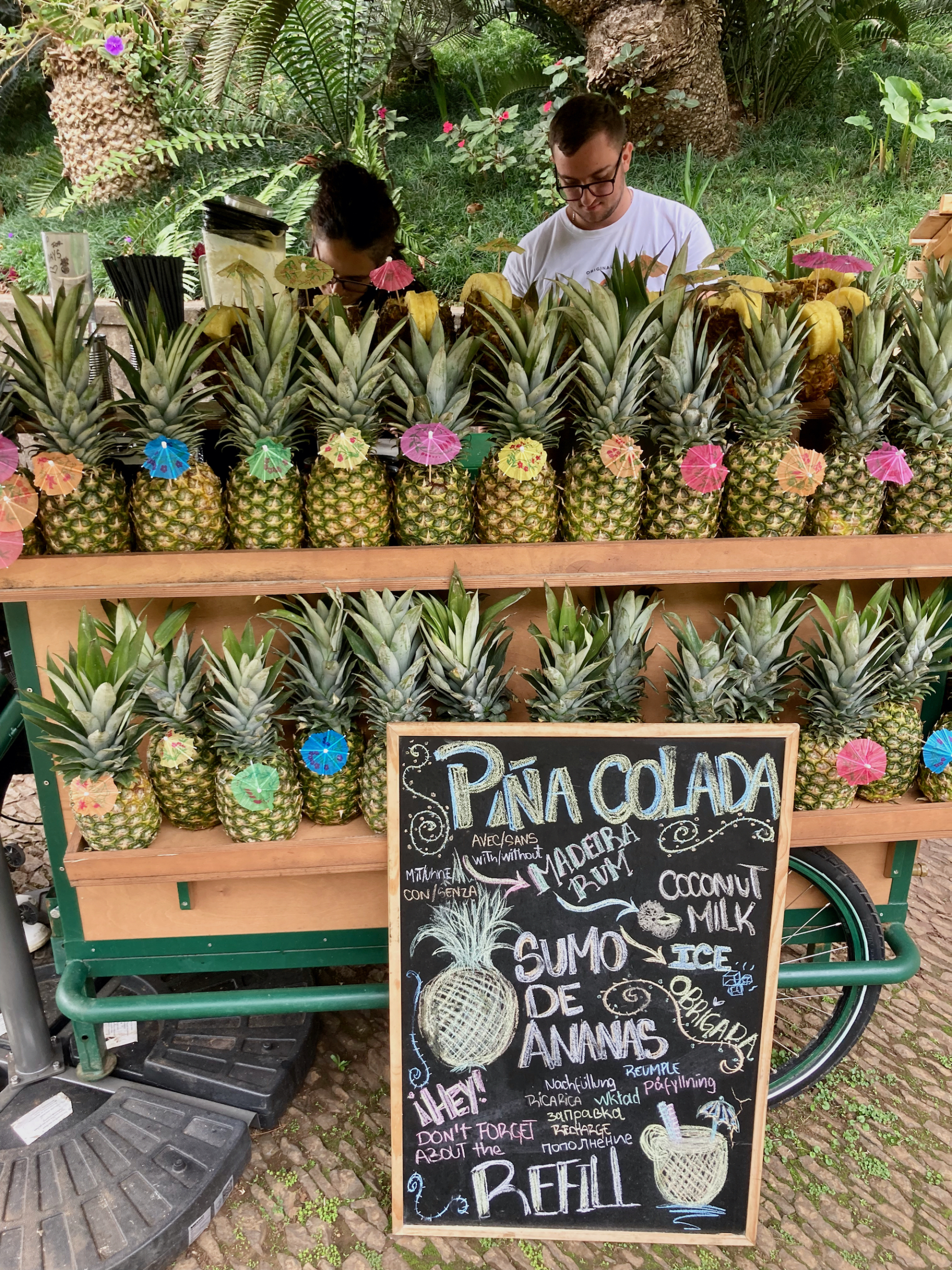
Szűrt ananászt jelent magyarul, szögezném le Móricka kedvéért… …akinek mint tudjuk, mindenről ugyanaz jut eszébe. Felhívnám továbbá a figyelmét az “ ñ ” betű kalapocskájára, ami által “ ny “-ne... Tartalom megtekintése
Történetek a füstölődő szalonnatáblák mellől
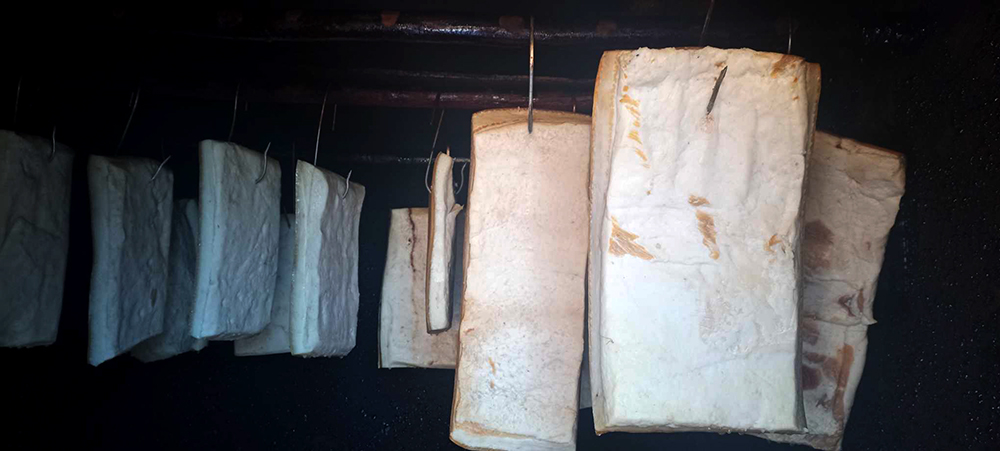
A régi házak padlásai mindig is kincseket rejtettek és rejtenek magukban Éreztem én ezt már gyerekkoromban, ugyanis állandóan azon siránkoztam, hogy mikor mehetek már fel én is a hijúba, ami... Tartalom megtekintése
Pince bejárat, Tokaj
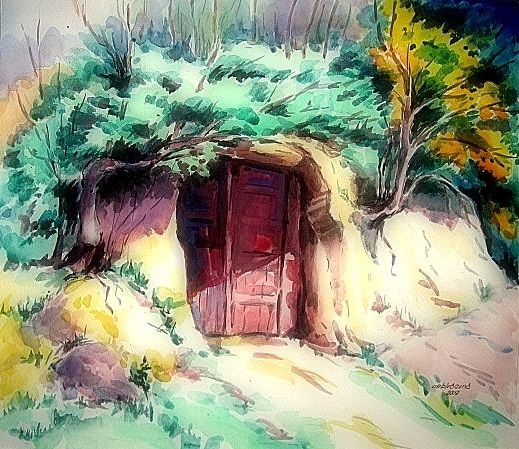
Bíró Ernő alkotása 30×42 cm, akvarell Ebben a rémítően szomorkás időben vágyódva nézhetünk erre a Bíró Ernő által megpingált képre. Kirobbanó fényekben pompázik a pince tetején dúsan hajtó ... Tartalom megtekintése
